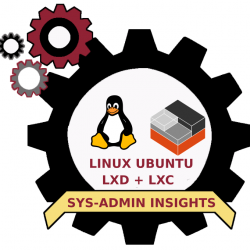We deploy LXC containers in quite literally ALL of our production services. And we have several development services, ALL of which are in LXC containers.
Why is that? Why do we use LXC?
The truthful answer is “because we are not Linux experts”. It really is true. Almost embarrassingly so in fact. Truth is, the SUDO command scares us: it’s SO POWERFUL that you can even brick a device with it (we know. We did it).
We have tried to use single machines to host services. It takes very little resources to run a Linux server, and even today’s laptops have more than enough hardware to support even a mid-size business (and we are not even mid-size). The problem we faced was that whenever we tried “sudo” commands in Linux Ubuntu, something at sometime would go wrong – and we were always left wondering if we had somehow created a security weakness, or some other deficiency. Damn you, SuperUser, for giving us the ability to break a machine in so many ways.
We kept re-installing the Linux OS on the machines and re-trying until we were exhausted. We just could not feel COMFORTABLE messing around with an OS that was already busy dealing with the pervasive malware and hacker threats, without us unwittingly screwing up the system in new and novel ways.
And that’s when the light went on. We thought: what if we could type in commands without worrying about consequences? A world where anything goes at the command line is…heaven…for those that don’t know everything there is to know about Linux (which of course definitely includes us!). On that day, we (re-) discovered “virtual machines”. And LXC is, in our view, the BEST, if you are running a linux server.
LXC allows us to create virtual machines that use fewer resources than the host; machines that run as fast as bare-metal servers (actually, we have measured them to be even FASTER!). But more than that, LXC with its incredibly powerful “snapshot” capability allows us to play GOD at the command line, and not worry about the consequences.
Because of LXC, we explore new capabilities all the time – looking at this new opensource project, or that new capability. And we ALWAYS ALWAYS run it in an unprivileged LXC container (even if we have to work at it) because we can then sleep at night.
We found the following blog INCREDIBLY USEFUL – it inspired us to use LXC, and it gives “us mortals” here at Exploinsights, Inc. more than enough information to get started and become courageous with a command line! And in our case, we have never looked back. We ONLY EVER use LXC for our production services:
We thank #UBUNTU and we thank #Stéphane Graber for the excellent LXC and the excellent development/tutorials respectively.
If you have EVER struggled to use Linux. If the command line with “sudo” scares you (as it really should). If you want god-like forgiveness for your efforts to create linux-based services (which are BRILLIANT when done right) then do yourself a favor: check out LXC at the above links on a clean Ubuntu server install. (And no, we don’t get paid to say that).
We use LXC to run our own Nextcloud server (a life saver in our industry). We operate TWO web sites (each in their own container), a superb self-hosted OnlyOffice document server and a front-end web proxy that sends the traffic to the right place. Every service is self-CONTAINED in an LXC container. No worries!
Other forms of virtualisation are also good, probably. But if you know of anything as FAST and as GOOD as LXC…then, well, we are surprised and delighted for you.
Regards,
SysAdmin ([email protected])

